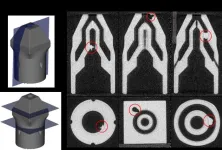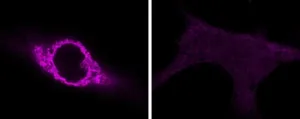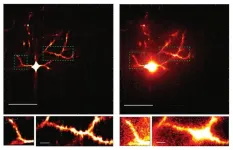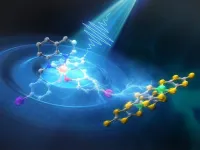(Press-News.org) Researchers at the University of Illinois Urbana-Champaign have developed a new method for detecting defects in additively manufactured components.
One of the most important tasks in any factory is to determine whether a manufactured component is free of defects. In additive manufacturing (3D printing), it can be particularly challenging to find defects, because additive manufacturing can make components that have complex three-dimensional shapes and important internal features that are not easily observed.
The novel technology uses deep machine learning to make it much easier to identify defects in additively manufactured components. To build their model, researchers used computer simulations to generate tens of thousands of synthetic defects - which exist only in the computer. Each computer-generated defect had a different size, shape, and location, allowing the deep learning model to train on a wide variety of possible defects and to recognize the difference between components that were defective and those that weren’t. The algorithm was then tested on physical parts, some of which were defective and some of which were defect-free. The algorithm was able to correctly identify hundreds of defects in real physical parts that have not previously been seen by the deep learning model.
“This technology addresses one of the toughest challenges in additive manufacturing,” said William King, Professor of Mechanical Science and Engineering at Illinois and the project leader. “Using computer simulations, we can very quickly build a machine learning model that identifies defects with high accuracy. Deep learning allows us to accurately detect defects that were never previously seen by the computer.”
The research, published in the Journal of Intelligent Manufacturing in a paper titled “Detecting and classifying hidden defects in additively manufactured parts using deep learning and X-ray computed tomography,” used X-ray computed tomography to inspect the interior of 3D components having internal features and defects that are hidden from view. Three-dimensional components can be easy to make with additive manufacturing, but difficult to inspect when important features are hidden from view.
The authors are Miles Bimrose, Sameh Tawfick, and William King from University of Illinois Urbana-Champaign; Davis McGregor from University of Maryland; Chenhui Shao from University of Michigan; and Tianxiang Hu, Jiongxin Wang and Zuozhu Liu from Zhejiang University.
END
Researchers use machine learning to detect defects in additive manufacturing
2024-06-04
ELSE PRESS RELEASES FROM THIS DATE:
Rare disease’s DNA-damaging mutation could have consequences for more common conditions
2024-06-04
TREX1 is a gene that is supposed to direct the maintenance of the entire body’s DNA, but new research shows that when people are born with mutated TREX1, it causes catastrophic damage to the DNA over time, resulting in a deadly rare disease called retinal vasculopathy with cerebral leukoencephalopathy (RVCL). Published in Nature Communications, the research was led by teams at the Perelman School of Medicine at the University of Pennsylvania and the Brain Research Institute at Niigata University in Japan.
While it was already known that a mutation in TREX1 was behind RVCL, the mechanism by which ...
Exploring three frontiers in marine biomass and blue carbon capture
2024-06-04
A new study offers first-time insights into three emerging climate innovations to safeguard or increase the carbon naturally captured by ocean and coastal ecosystems: rapid interventions to save the Great Barrier Reef, satellite-tracked kelp beds in the deep ocean, and seagrass nurseries in the United Kingdom. The research, published in Environmental Science & Policy and co-authored by leading climate scholars at Boston University, Aarhus University, and the University of Sussex Business School, advances knowledge of understudied interventions in marine ...
Microscope system sharpens scientists’ view of neural circuit connections
2024-06-04
The brain’s ability to learn comes from “plasticity,” in which neurons constantly edit and remodel the tiny connections called synapses that they make with other neurons to form circuits. To study plasticity, neuroscientists seek to track it at high resolution across whole cells, but plasticity doesn’t wait for slow microscopes to keep pace and brain tissue is notorious for scattering light and making images fuzzy. In a paper in Scientific Reports, a collaboration of MIT engineers and neuroscientists describes a new microscopy system designed for fast, clear, and frequent imaging of the living brain.
The system, ...
VHIO researchers demonstrate the utility of high-sensitivity liquid biopsy to predict and monitor response to immunotherapy
2024-06-04
The liquid biopsy technique applied in this work is based on the sequencing of the entire tumor genome from 138 patients and the monitoring of mutations in the blood. This approach achieves high sensitivity in detecting the tumor signal in the blood (1/1,000,000 DNA molecules), and the patterns found reflect how patients respond to immunotherapy.
This study is part of the Comprehensive Program of Cancer Immunotherapy and Immunology (CAIMI) at VHIO, funded by the BBVA Foundation, and is co-led by Dr Rodrigo Toledo, head of the Biomarkers and Clonal Dynamics Group at the Vall d’Hebron Institute of Oncology (VHIO), ...
Muscle disorder caused by key protein mutations uncovered in new study
2024-06-04
A recent study has found that the SMCHD1 protein plays a key role in controlling how genes are processed, which affects the progression of Facioscapulohumeral Muscular Dystrophy (FSHD). This discovery about SMCHD1's function in gene regulation is important because it opens new possibilities for developing targeted therapeutic strategies to combat the disease. By understanding more about how SMCHD1 works, scientists can explore new ways to fight the disease.
A recent study by MD-PhD student Eden Engal under the guidance of Dr. Yotam Drier and ...
Observing ultrafast photoinduced dynamics in a halogen-bonded supramolecular system
2024-06-04
Researchers uncover how the halogen bond can be exploited to direct sequential dynamics in the multi-functional crystals, offering crucial insights for developing ultrafast-response times for multilevel optical storage.
Halogen bonds are intermolecular interactions that arise from the attraction between a halogen atom (group 17 elements in the periodic table) and another atom with lone pairs, more generally a molecular entity with high electron density. Understanding the distinctive and highly directional nature of halogen bonds is crucial for crystal engineering and studying ...
USPSTF recommendation statement on interventions to prevent falls in community-dwelling older adults
2024-06-04
Bottom Line: The U.S. Preventive Services Task Force (USPSTF) recommends exercise interventions to prevent falls in community-dwelling adults 65 years or older who are at increased risk for falls. The USPSTF recommends that clinicians individualize the decision to offer multifactorial interventions to prevent falls to community-dwelling adults 65 years or older who are at increased risk for falls. Existing evidence indicates that the overall net benefit of routinely offering multifactorial interventions to prevent falls is small. When determining ...
ASCO: Proton therapy demonstrates advantages in Phase III head and neck cancer trial
2024-06-04
ABSTRACT 6006
CHICAGO ― According to preliminary data from a multi-institution Phase III trial led by researchers at The University of Texas MD Anderson Cancer Center, intensity modulated proton therapy (IMPT) achieved similar clinical outcomes and offered significant patient benefits when compared to traditional intensity modulated radiation therapy (IMRT) as part of chemoradiation treatment for patients with oropharyngeal (head and neck) cancer.
The results were presented today at the 2024 American Society of Clinical Oncology (ASCO) Annual Meeting by Steven Frank, M.D., professor of Radiation Oncology and executive director of the Particle ...
Mapping lava flows with groundbreaking field instrument
2024-06-04
WASHINGTON, June 4, 2024 – Millions of people live near active volcanoes that are constantly monitored for signs of an impending eruption. When one occurs, scientists and governments rely on data to estimate the extent of the possible damage, informing evacuation plans and disaster response efforts. The nature of eruptions, unfortunately, means collecting data about them can sometimes be as challenging as organizing a response.
In Review of Scientific Instruments, by AIP Publishing, researchers from the University at Buffalo developed a tool for measuring the viscosity of lava that could increase our understanding of molten rock as well as better improve ...
Access to prostate-specific antigen testing and mortality among men with prostate cancer
2024-06-04
About The Study: This population-based cohort study of men with prostate cancer suggests that higher county-level prevalence of prostate-specific antigen (PSA) screening was associated with lower odds of advanced disease, all-cause mortality, and prostate cancer–specific mortality. Associations varied by age, race and ethnicity, and U.S. Census region.
Corresponding Author: To contact the corresponding author, Hari S. Iyer, Sc.D., M.P.H., email hari.iyer@rutgers.edu.
To access the embargoed study: Visit ...






